Newly Added Knit Patterns
- Banff Raglan Sport Sweater, Cap and Gloves Pattern #3712
- Vardon Sport Jacket Pattern #3711
- Saville Row Evening Scarf Pattern #3731
- Knitted Knee Cap Pattern #3730
- Golf Mittens Pattern #3729
- Frontenac Sport Sweater, Cap and Gloves Pattern #3710
- Forest Hills Sleeveless Slip-Over Pattern #3709
- Ranleigh Polo Shirt Pattern #3708
- Harrowgate Coat Sweater Pattern #3707
- Socks Pattern #3728
- Sport Socks Pattern #3727
- Helmet Pattern #3732
New Trends in Hand Knit Sweaters | Bernhard Ulmann Volume 7
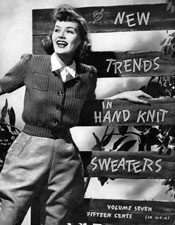
New Trends in Hand Knit Sweaters
Bernhard Ulmann 7
Original Copyright 1940
| ENTIRE DIGITALLY RESTORED LEAFLET IN .pdf FORMAT AVAILABLE FOR PURCHASE |
 |
Sweet sweaters – suave sweaters – woolly ones to keep you warm – lacy ones to keep you lovely – cardigans – pullovers – jackets ... SWEATERS!
You'll find them so practical and so pretty that you'd never even dream of trying to get through the season without at least one of them! And it's just as easy on your budget as it is smart to have them – when you make them yourself!
You can let your fancy roam free. Combine the colors you've always wanted to wear and never found that way in anything ready-made. You can create perfect companions for your suits – your skirts – your slacks. You can revolutionize your wardrobe, with your own hands, and with deep enjoyment!
Check Your Gauge First – Before starting your garment; knit a small sample. If you cannot procure the exact gauge given in the direction, try a needle one or even two sizes smaller or larger until you obtain the exact gauge specified for the garment you intend to make. The needles recommended in the directions are based as nearly as possible on the average knitter's work, but because some knitters work tightly and others loosely, we suggest you test your own work first to verify the gauge.
If you find you have to use a different size needle than that called for in the directions, the change will not in any way alter your garment, provided your gauge is in accordance with that called for in the directions.
In making a garment, always count the rows on the front and back, being careful to have the same number on each piece. Count the rows in same way on each sleeve.
Directions for Garments in This Book Are Based on the Following Measurements:
| Bust | Waist | Hips* | |
| Size 16 (Size 34) | 35 inches | 28 inches | 37 inches |
| Size 18 (Size 36) | 37 inches | 30 inches | 39 inches |
| Size 20 (Size 38) | 39 inches | 32 inches | 41 inches |
| Size 40 | 41 inches | 34 inches | 43 inches |
| Size 42 | 43 inches | 36 inches | 45 inches |
*Hips (7 inches below waist)
To Change Size of Garments to Another Regulation Size – Add the number of sts required to make 1 inch (see gauge at beginning of directions for garment to be made) to both the back and front of garment for each size larger than the size given in directions; or subtract the number of sts required for 1 inch from both back and front for each size smaller. When a pattern stitch is used, add (or subtract) the number of sts given for 1 or more repeats (or "multiples") of pattern, according to the number of inches required. Then follow the directions given. When shaping armholes, bind off 1 st more each side for one size larger (1 st less each side for one size smaller). Make the armhole ¼ inch longer at both back and front for one size larger (¼ inch shorter for one size smaller). When shaping shoulders, bind off more (or less) sts than given in directions for shoulders and back of neck, adding ⅓ of the extra sts to each shoulder and remaining sts to back of neck. When casting on the sts for lower edge of sleeve, add ¼ inch for each size larger, then increase ¼ inch extra. This will make sleeve ½ inch wider at underarm for each size larger.
If You Vary from a Regular Size – Take your own measurements wherever you differ from the size given in the directions. Multiply the number of inches of each of these measurements by the number of sts (or rows) equivalent to 1 inch, to obtain the number of sts (or rows) required at each particular place where it is nec-essary to make your garment larger, or smaller. Follow directions given, changing number of decreases or increases, to obtain desired width or the number of rows between decreases or increases to obtain desired length.
To Wash Knitted Garments – First take complete measurements of your garment, then using Lux Soap Flakes, make thick suds with hot water; then add enough cold water to make it lukewarm (comfortable wrist temperature). Avoid using hot water which shrinks wool. Immerse garment and gently work suds through the fabric-do not rub or twist or allow the weight of the garment to pull it out of shape. Keep the garment supported in the hands when squeezing out water.
Rinse thoroughly in three lukewarm waters immediately after washing, squeezing garment gently between the hands to remove soap. Do not twist or wring. Roll garment between two turkish towels to knead out excess moisture - unroll at once and shape garment according to original measurements, leaving it on turkish towel. Let it dry slowly, not forgetting to stretch it frequently into its natural shape, according to measurements. While garment is still damp, block according to directions.
To Block or Steam Yarn Garments – Turn garment wrong side out. Lay flat on a pressing board. Pin edges of garment if necessary to make it lie flat. Lay a wet cloth over garment. Pass a hot iron over the cloth allowing the steam to go through the garment. Do not allow the weight of the iron to rest on the garment. Leave garment pinned until thoroughly dry.
To Stretch Pattern Stitch Garments in Blocking – In special cases when a stitch of the rib type is used, it is necessary to stretch garments out to their correct width. Pin garment to pressing board, stretching to measurements given for finished garment. Then follow directions for steaming yarn garments, using enough pressure on iron so that garment will retain desired measurements. Be careful not to flatten pattern too much or to leave mark of the iron by pressing too hard.
When Garment Is Not in Use – Be sure to lay your garment flat when not in use.
Buy Sufficient Material – At the time you make your initial purchase of the yarn for the garment you intend to make, it is important that you buy the complete amount of each color necessary to finish the article, making sure that it is all of one dye lot number as the next lot number of any color may differ slightly in shade from the original lot you purchased and make it impossible to complete your garment satisfactorily.
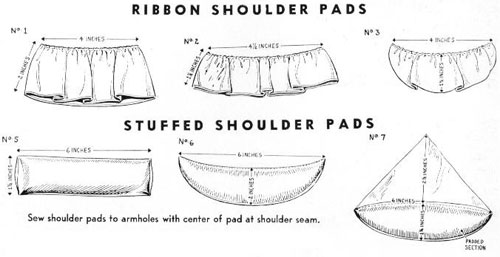
ABBREVIATIONS AND TERMS USED IN KNITTING AND CROCHETING
ch-chain
s c-single crochet
s d c-short double crochet
h d c-half double crochet
d c-double crochet
k-knit
p-purl
tr-treble
st-stitch
tog-together
y o-yarn over
in.-inch
ins.-inches
no.-number
slip, k and pass-slip 1, k 1, pass the slipped st over the knitted st.
An Asterisk (*) indicates that the directions immediately following are to be repeated the given number of times, in addition to the original. Thus "repeat from * 3 times" means to make 4 times in all.
The ** and † are used in the same way.
Even means that a row is to be worked without either increase or decrease.
Over means to throw the yarn over the right-hand needle, which is another way of increasing a st.
Work means to continue in the stitch which has been described.
Knitting Patterns
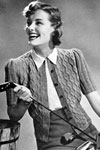
Width across back at underarm 16 ¾ ins. Width across back at shoulders 14 ins. Width of each front at underarm 10 ins. Length from lower edge to back neck edge 19 ¾ ins. Sleeves-Width below underarm 12 ½ ins.
BACK-With size 1 needles cast on 109 sts for lower edge.
Begin Rib Pattern. (More)

Width across back at lower edge and underarm 16 ins. Width across back at shoulders 12 ¾ ins. Width of each front at lower edge and underarm 10 ½ ins. Length from lower edge to back neck edge 23 ins. Sleeves-Width below underarm 12 ¾ ins.
Pattern is a multiple of 4 plus 1.
BACK-Cast on 113 sts for lower edge. (More)

Width across back at underarm 17 ins. Width across back at shoulders 13 ins. Width across front at underarm 18 ½ ins. Length from lower edge to back neck edge 19 ins. Sleeves-Width below underarm 13 ins.
BACK-With size 1 needles cast on 116 sts for lower edge.
Work in ribbing of k 2, p 2 for 3 ½ ins. (More)

Bust 35 inches. Width across back at underarm 17 ins. Width across back at shoulders 12 ½ ins. Length from lower edge to back neck edge 18 ins. Sleeves - Width below underarm 12 ½ ins.
SHOULDER PIECES-Cast on 12 sts on circular needle and work back and forth in stockinette st (p 1 row, k 1 row) for 8 inches, ending with a p row. Break yarn and slip sts to a strand of yarn. K side is right side. Make a 2nd piece in same way. (More)

Width across back at underarm 17 ins. Width across back at shoulders 12 ¾ ins. Width across each front at underarm 9 ¾ ins., including crochet band. Length from lower edge to back neck edge 19 ¼ ins. Sleeves -Width below underarm 13 ½ ins.
Pattern at lower edge is a multiple of 4.
BACK-With size 10 needles, cast on 56 sts for lower edge. (More)
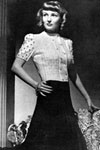
Width of back at underarm 16 ¾ ins. Width of back at shoulders 12 ¾ ins. Width of each front at underarm 10 ¾ ins. including crochet edge. Length from lower edge to back neck edge 19 ins. Sleeves-Width below underarm 12 ½ ins.
SAMPLE OF PATTERN STITCH
Pattern is a multiple of 10 plus 9. (More)
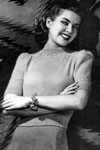
Bust 35 ins. Width across back at underarm 16 ½ ins. Width across back at shoulders 13 ½ ins. Length from lower edge to back neck edge 18 ½ ins. Sleeves - Width below underarm 13 ½ ins.
BACK-Cast on 102 sts for lower edge. Work in ribbing of k 1, p 1 for 4 ins.
Increase row-K 6, increase 1 st in next st, * k 2, increase 1 st in next st; repeat from * 29 times, k 5 (133 sts). Work even in stockinette st (p 1 row, k 1 row) for 7 ½ ins. (More)
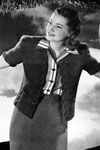
Width across back at underarm 17 ¼ ins. Width across back at shoulders 13 ins. Width of each front at underarm 9 ¼ ins. Length from lower edge to back neck edge 21 ¼ ins. Sleeves - Width below underarm 12 ¾ ins.
BACK-Cast on 56 sts for lower edge. Work stockinette st (p 1 row, k 1 row) until 13 ins. above lower edge. (More)
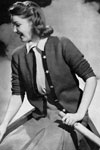
Width across back at underarm 18 ins. Width across back at shoulders 15 ins. Width of each front at underarm 9 ½ ins. Length from lower edge to back neck edge 24 ins. Sleeves-Width below underarm 13 ins. Length from lower edge to underarm 20 ins.
BACK-With size 4 needles, cast on 98 sts for lower edge.
Ribbing-First row (right side)-K 2, * p 2, k 2, repeat from * across row. (More)

Width across back at underarm 17 ½ ins. Width across back at shoulders 13 ins. Width of each front at underarm 10 ½ ins. Length from lower edge to back neck edge 19 ½ ins. Sleeves-Width below underarm 13 ins.
Pattern Stitch is a multiple of 4 plus 1.
BACK-With size 0 needles, cast on 126 sts for lower edge. (More)
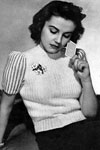
Bust 36 ins. Width across back at underarm 17 ¼ ins. Width across back at shoulders 13 ins. Length from lower edge to back neck edge 21 ¼ ins. Sleeves-Width below underarm 12 ins.
Entire sweater is worked in ribbing of k 2, p 2.
BACK-With size 1 needles, cast on 114 sts for lower edge. First row (wrong side)- * K 2, p 2; repeat from *, ending k 2. (More)
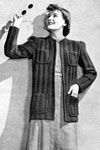
Width across back at lower edge 18 ins.; each front 10 ins. Width across back at underarm 18 ins.; each front 10 ins. Length from lower edge to underarm 22 ins. (Box coat 15 ins.) Sleeves-Width below underarm 14 ins. Length from lower edge to underarm 17 ins.
Pattern is a multiple of 6 plus 1.
BACK-Cast on 61 sts for lower edge. (More)
| Pattern Categories Browse the categories to help you find the patterns you're looking for. |
||
|
||










